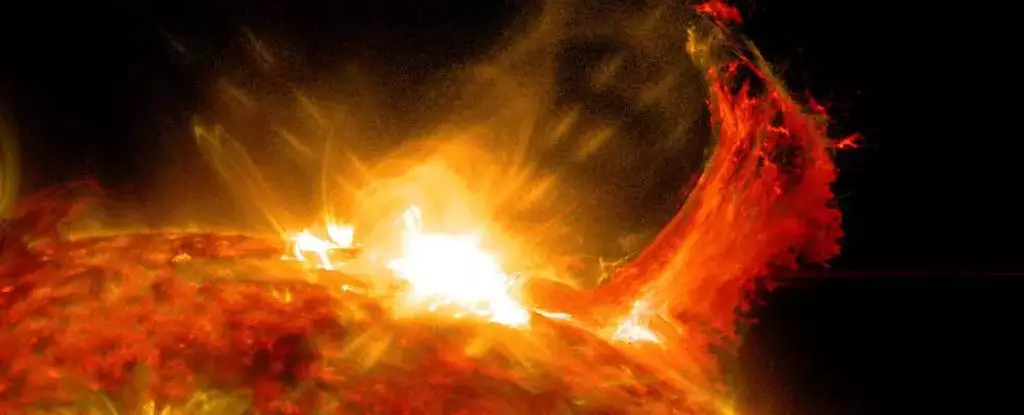The Sun, our closest star, is often perceived as a steadfast source of warmth and light, but it is, in reality, a volatile sphere driven by powerful forces that create tumultuous activity. Far from being a mere source of light for our planet, the Sun experiences a cycle of convection, magnetic field fluctuations, and energy eruptions that could have profound implications for life on Earth. These phenomena include solar flares, which are bursts of radiation, and coronal mass ejections (CMEs), vast bursts of solar wind and magnetic fields rising from the solar corona or being released into space. Understanding the frequency and potential impact of these intense solar events is crucial for our society, which relies heavily on technology that could be vulnerable to such cosmic disturbances.
Recent research has shed light on the frequency of solar superflares, events that surpass the intensity of the commonly understood solar flares. Previously, estimations of their occurrence ranged anywhere from once every century to millennia. However, new analytical results based on the observation of 56,400 stars akin to our Sun suggest that these formidable events might transpire once every 100 years. This forecast not only highlights a potentially alarming frequency but also raises concerns considering that even historically significant solar events, like the Carrington Event in 1859, were much less potent than these predicted superflares. Such projections indicate a dire need for increased preparedness against the potential dangers posed by these solar phenomena.
The Challenges of Measuring Solar Activity
Understanding and yielding accurate data about solar behavior is considerably complicated. The Sun operates on a timescale that defies straightforward observation, and historical records that span centuries are sparse. While tree-ring data and ice core samples show spikes in carbon-14 and nitrogen, hinting at past solar activity, these methods provide an incomplete picture of the Sun’s behavior. The pursuit of studying G-type yellow dwarfs (such as our Sun) adds another layer of complexity, as the variable nature of these stars makes it challenging to assess their rotation rates—a crucial factor in flare activity. By including stars with undefined rotation periods but similar attributes, researchers employed innovative methods to collate a significant sample size that could shed light on larger statistics of solar eruptive activity.
A Surprising Rate of Superflare Activity
The research team, led by astronomer Valeriy Vasilyev from the Max Planck Institute, discovered that their extensive examination resulted in 2,889 recorded superflares across 2,527 stars. This staggering insight into solar behavior indicated the troubling rate of flare activity—as mentioned, approximately once every century—which provokes questions about our own star’s future behavior. Flares may seem sporadic and harmless, yet if the Sun were to unleash a superflare similar to those observed in other stars, the ramifications for Earth’s infrastructure could be catastrophic.
To contextualize the implications of these solar phenomena, it is essential to explore historical events that have already demonstrated their capacity for disruptions. The Carrington Event disrupted telegraph systems worldwide, and a geomagnetic storm in 1989 resulted in significant power outages across North America. Such incidents place the potential threats of superflares into a stark reality. Interestingly, researchers have identified multiple historic events, referred to as Miyake events, which may have been even more potent than the Carrington Event, suggesting that we may not have fully experienced the worst that the Sun can offer.
The correlation between solar flares and coronal mass ejections is another vital area of investigation. Not every flare results in a CME, yet CMEs tend to cause the most severe consequences on Earth through the generation of geomagnetic storms. Astrophysicist Ilya Usoskin acknowledges the ambiguity in understanding the full relationship between solar flares and particle events. The ongoing research indicates a pressing need for more accurate predictions and preparedness, as these extreme solar events are integral to the Sun’s natural behavior—and a potential threat to our modern society.
As we embark on a deeper understanding of solar dynamics, it has become increasingly clear that accurate forecasting of solar activity is our primary line of defense against geomagnetic storms resulting from superflare events. The research leads to a sobering yet essential observation: while the Sun serves as our life-giving star, it also holds the capacity to significantly disrupt our technological infrastructure if we remain unprepared. Bolstering our knowledge and strengthening our systems can shield us from the randomness of the Sun’s wrath. Understanding and anticipating these cosmic behaviors is crucial for our continued existence in an age dependent on technology and communication.

